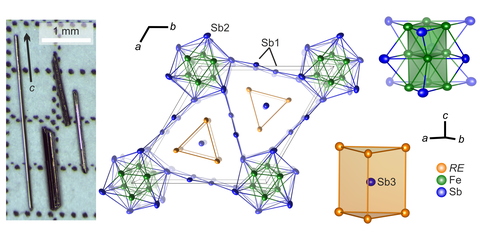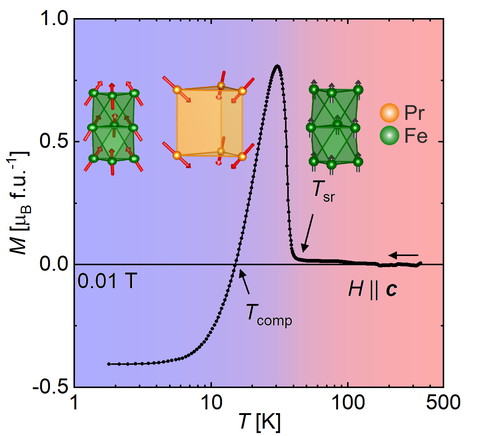Unconventional Spin State in a Praseodymium Iron Antimonide
To gain a detailed understanding on the atomic scale of magnetic properties is crucial for the tailored design of magnetic materials. Compounds from rare earth and transition metal elements have attracted large research interest for a long time. They combine the two worlds of itinerant (3d) and localized (4f) electrons. Their interplay has been the origin of multiple interesting magnetic phenomena.
The ternary intermetallic Pr3Fe3Sb7 has been described as a novel representative of such compounds. For the first time, crystal growth of mm-sized, needle-like crystals succeeded in a molten bismuth flux. They allowed the directional investigation of bulk magnetization and electrical transport properties. Cooling samples in an external magnetic field parallel to the c axis revealed a strong temperature and field dependency of the magnetization. A negative magnetization (opposite to the field direction) was observed that does not originate from superconductivity.
Combined magnetization measurements, Mößbauer spectroscopy and powder neutron diffraction gave detailed insights into this behavior. The crystal structure is composed of two spatially separated substructures of iron and praseodymium connected by an antimony framework. At low temperatures, a competing interaction between the two substructures emerges with antiparallel arrangement of the Fe and Pr moments. Magnetocrystalline anisotropy preserves the initial orientation of the moments, which results in the negative magnetization. At room temperature, only the moments of the iron substructure undergo long range ordering. As demonstrated by Mößbauer spectroscopy in field and zero-field conditions, two iron site coexist that feature different orientations of the moments.
The investigation of the complex magnetism in the ternary compound provides new insight into the possible magnetic interaction of intermetallic compounds. Since changes in temperature and external field result in a strong magnetic response, the material can potentially be used for magnetic switching.
The article can be found in Advanced Materials:


